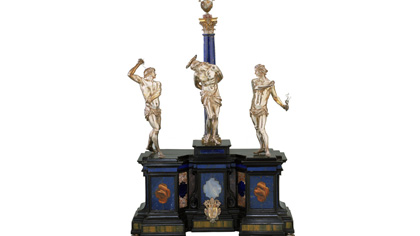The Flagellation of Christ
The Flagellation of Christ, ca. 1630
Alessandro Algardi, (Italian, 1598–1654) and François Du Quesnoy (Flemish, 1597–1643)
Cast silver, silver gilt, lapis lazuli, agate, ebony, and agate
Gift of Mr. and Mrs. Charles W. Engelhard, 1969-07
Each of the Evangelists recounts the flagellation of Christ. Upon the orders of Pontius Pilate, the governor of Judea, soldiers flogged Christ before leading Him to His crucifixion. Although descriptions by the Evangelists regarding the flagellation offer little detail, Renaissance artists began the tradition of depicting Christ bound to a Corinthian column. This could be a reference to the colonnade of Pilate's judgement hall. In the D'Arcy example, the Corinthian column, made of lapis lazuli, is mounted by an agate urn which holds relics.
The coat of arms displayed on the ebony base indicates the work once belonged to Pope Alexander VII, a great patron of the arts. A close friend of Queen Christina, Alexander may have given the Swedish queen this work as a gift, since a work fitting this description was listed in the queen's inventory.
The beauty and elegance of this highly stylized work presents a paradox to the subject of the flagellation, a painful moment in the life of Christ. The richness of material and elegance of execution deny the harsh reality of the suffering Christ endured.
Scholars have attributed the figures to two different sculptors working in the High Baroque style, Alessandro Algardi and Français Du Quesnoy. Both Algardi and Du Quesnoy worked in Rome, and were associated with the papal elite. Qualities of elegance, refinement, and expert execution define the artists' work.


